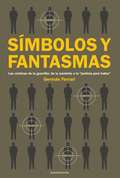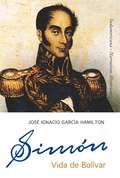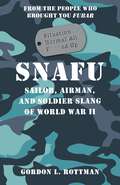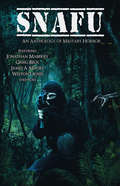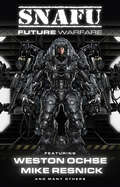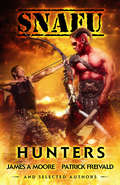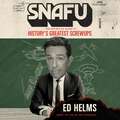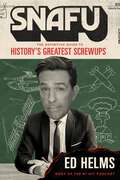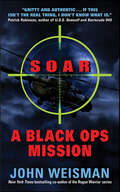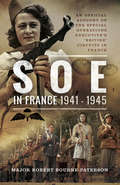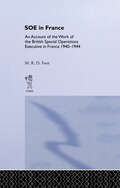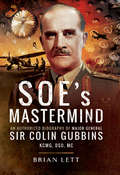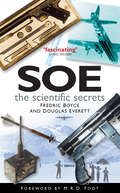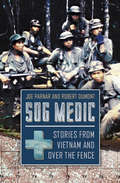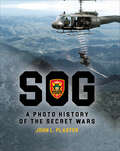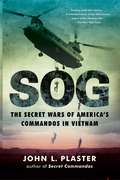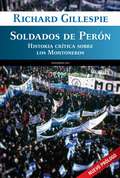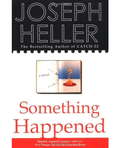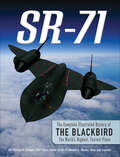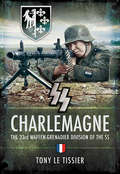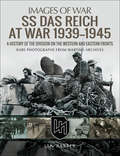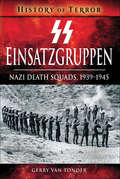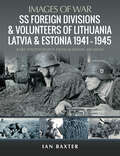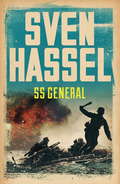- Table View
- List View
SIMBOLOS Y FANTASMAS (EBOOK)
by Germán FerrariPor qué la evocación en torno de las víctimas de la guerrilla implica siempre de manera explícita o velada una reivindicación de la última dictadura militar? Partiendo de cuatro casos emblemáticos de víctimas atribuidas a la guerrilla -Argentino del Valle Larrabure, Pedro Eugenio Aramburu, Jordán Bruno Genta y José Ignacio Rucci-. Germán Ferrari indaga en las relaciones entre estos personajes y la aparición de un nuevo discurso que equipara el terrorismo de Estado con las acciones de las organizaciones milicianas. Los casos elegidos reúnen todos los elementos necesarios para ensayar una respuesta a ese interrogante crucial ante la construcción de un futuro sin lastres de autoritarismo. Fueron símbolos para la última dictadura y son fantasmas que aún acosan a esta democracia imperfecta. A través de testimonios, archivos periodísticos y documentos judiciales, entre otras fuentes, el autor de esta investigación bucea en el resurgimiento, en los últimos años, de la denominada "teoría de los dos demonios", a partir de la reapertura de los juicios a represores del régimen que imperó en el país entre 1976 y 1983. Y analiza la estrategia desplegada por diversos sectores del centro a la derecha para calificar como "crímenes de lesa humanidad" a los atentados de la guerrilla. Símbolos y fantasmas demuestra cómo detrás del lema "justicia para todos" se oculta una realidad más compleja, en la que se mezclan el dolor y el oportunismo político.
SIMON (EBOOK)
by Jose Garcia HamiltonJosé Ignacio García Hamilton le devuelve a Simón Bolívar su dimensión humana y lo muestra como un ser creíble que, más allá de su relevante periplo, participa de las debilidades de cualquier persona. El huérfano indefenso; el diplomático rechazado por homosexual; el demagogo que adula a los mestizos; el militar ambicioso; el tío que encuentra la pasión con una sobrina; el hombre que tiene celos de su vicepresidente Santander, se va convirtiendo en un comandante implacable que declara la "guerra a muerte", fusila sin piedad a los prisioneros y se constituye en dictador. La relación con la estridente lesbiana Manuela Sáenz; la entrevista de Guayaquil con el debilitado general San Martín; la seducción de las esposas de sus oficiales en El Cuzco y Potosí; el sueño de ser coronado como emperador, y la búsqueda del protectorado de Inglaterra van configurando un personaje egocéntrico y a la vez generoso, cruel y magnánimo, pero siempre fascinante. Las oscilaciones de este luchador por la independencia y amante del poder absoluto; sus pendulaciones entre los aportes libertarios y su inclinación por la tiranía; su retórica democrática y el afán de hacer constituciones a su medida, constituyen todavía un símbolo del auge y ocaso de una América española paradójicamente esclavizada por sus supuestos libertadores.
SNAFU Situation Normal All F***ed Up
by Gordon RottmanA follow-up to 2007's highly successful FUBAR: Soldier Slang of World War II, SNAFU covers the slang of sailors and airmen, as well as soldiers. Military life has always been ruled by its own language, specific sets of terms and phrases that separate the serving man or woman from their civilian counterpart. There is the official version of ranks and acronyms, and the more unofficial, colloquial language of the barrack room and battlefield - both are covered in this humourous look at soldier slang. World War II saw vast numbers of young men and women pass through the ranks of the various armies involved, and they inherited and developed a vocabulary in response to their unique situations - many of whose words and phrases have passed into the common vernacular and are still in use right up to the present day. SNAFU explores the language and slang of the major combatant powers, delving into their origins and explaining their uses, all illustrated with contemporary cartoons and other images showing the phrases in use. Detailed sections are included for each of the major combatants of World War II, and additional appendices detail the nicknames given to the major surface vessels and aircraft types of the war.
SNAFU: An Anthology of Military Horror
by Weston Ochse Jonathan Maberry James A. Moore Greig BeckWar is hell . . . Soldiers fight to survive. They fight each other, and they fight the demons inside. Sometimes, they fight real monsters. This book collects stories of ancient myths, time travelers, horrors in the old west . . . and the soldiers who fight them. Featuring some of the best writers working in the field today, this book includes works from Jonathan Maberry, Weston Ochse, Greig Beck, and James A. Moore who lead the way, with a contingent of emerging authors to back them up. Fight or die.
SNAFU: Future Warfare
by Amanda J. Spedding Geoff BrownJoin the military, they said. See far-flung worlds, they said. Meet interesting creatures, and kill them all. Soldiers fighting aliens in unforgiving landscapes, where every breath could be their last. Featuring stories by Weston Ochse, Mike Resnick, and others. From near-future to far-future, featuring some of the best writers working in the field today.
SNAFU: Hunters
by Amanda J. Spedding Geoff BrownEveryone has a hobby.Some collect stamps, frequent fine dining, or travel.Some hunt creatures so dangerous and evil most would run screaming the other way.Demons, monsters, whatever.It's just a job, and someone has to do it.A collection of fine stories based on hunting things that walk the night.For lovers of Supernatural, Hunted, and perhaps even Duck Dynasty.
SNAFU: the hilarious new book from The Office and Hangover comedian
by Ed HelmsFrom actor, comedian, writer, and host of the hit history podcast SNAFU, Ed Helms brings you an absurdly entertaining look at history's greatest screwups, complete with lively illustrations. History contains a plethora of insane screwups-otherwise known as SNAFUs. Coined during World War I, SNAFU is an acronym that stands for Situation Normal: All F*cked Up. In other words, "things are pretty screwed up, but aren't they always?"Spanning from the 1950's to the 2000's, Ed Helms steps in as unofficial history teacher for a deep dive into each decade's craziest SNAFUs. From planting nukes on the moon to training felines as CIA spies to weaponizing the weather, this book will unpack the incredibly ironic decision-making and hilariously terrifying aftermath of America's biggest mishaps.Filled with sharp humor and lively illustrations, SNAFU is a wild ride through time that not only entertains but offers fresh insights that just might prevent history from repeating itself again and again.
SNAFU: the hilarious new book from The Office and Hangover comedian
by Ed HelmsFrom actor, comedian, writer, and host of the hit history podcast SNAFU, Ed Helms brings you an absurdly entertaining look at history's greatest screwups, complete with lively illustrations. History contains a plethora of insane screwups-otherwise known as SNAFUs. Coined during World War I, SNAFU is an acronym that stands for Situation Normal: All F*cked Up. In other words, "things are pretty screwed up, but aren't they always?"Spanning from the 1950's to the 2000's, Ed Helms steps in as unofficial history teacher for a deep dive into each decade's craziest SNAFUs. From planting nukes on the moon to training felines as CIA spies to weaponizing the weather, this book will unpack the incredibly ironic decision-making and hilariously terrifying aftermath of America's biggest mishaps.Filled with sharp humor and lively illustrations, SNAFU is a wild ride through time that not only entertains but offers fresh insights that just might prevent history from repeating itself again and again.
SOAR: A Black Ops Mission
by John WeismanBLACK OPS: The shadow wars; the down-and-dirty work of CIA/Special Operations ...On the eve of a groundbreaking U.S.–China summit, a covert CIA black ops team assigned to bug a Chinese nuclear test site is captured by Islamic terrorists. An explosive situation goes from bad to catastrophic when the terrorists ambush a Chinese army convoy, highjack a highly unstable nuclear device ... and arm it. On orders from the President, Major Michael Ritzik, the young CO of a top secret element of the Army's elite Delta Force, must lead his men on an impossible rescue/disarmament mission -- even as Beijing dispatches its own special forces to deal with the impending threat. Ritzik and his shadow warriors will need to employ speed, surprise, and violence of action to beat the Chinese to the target, free the captives, disarm the nuke, and escape without leaving any fingerprints. Failure is not an option -- because the unthinkable has suddenly become a very real possibility.
SOE in France, 1941–1945: An Official Account of the Special Operations Executive's French Circuits
by Robert Bourne-PattersonIn the archives of the Special Operations Executive lay a report compiled by a staff officer and former member of SOE's French Section, Major Robert Bourne-Patterson, that until recently could not be published. Because of the highly sensitive nature of the work undertaken by the SOE, the paper was treated as confidential and its circulation was strictly limited to selected personnel. Now, at last, it can be made available to the general public.Limited, also, was the time available to Bourne-Patterson in compiling his report in 1946 as the SOE was being wound up and many documents were being weeded from the files. Nevertheless, the paper he wrote gives a good picture of the work of the SOE in France, the country where its operations were most extensive. It contains an overview of operations in France by the Special Operations Executive during the Second World War with detailed records of individual circuits from their inception onwards, containing much information concerning individual agents and their contacts, calendars of subversive activity against the Germans and the names and addresses of personnel connected with the circuits who had survived the war. In writing his account, Bourne-Patterson drew heavily on personal interviews and wartime debriefings by agents.
SOE in France: An Account of the Work of the British Special Operations Executive in France 1940-1944 (Government Official History Ser.)
by M.R.D. FootSOE in France was first published in 1966, followed by a second impression with amendments in 1968. Since these editions were published, other material on SOE has become available. It was, therefore, agreed in 2000 that Professor Foot should produce a revised version. In so doing, in addition to the material in the first edition, the author has had
SOE's Mastermind: The Authorised Biography of Major General Sir Colin Gubbins KCMG, DSO, MC
by Brian LettThe first complete biography of Britain&’s WWII spymaster presents an intimate look at his life and career, as well as an insider&’s look at the SOE. Major General Sir Colin Gubbins was the driving force behind Britain&’s Special Operations Executive, the secret military organization established by Winston Churchill in 1940. First as its Operations and Training Director, and then its Commander, Gubbins orchestrated every aspect of the SOE&’s worldwide covert operations. Though Gubbins made enormous contributions to Allied victory, his life and work have remained shrouded in secrecy until now. With copious research and unprecedented access to family archives, biographer Brian Lett reveals the war hero&’s early experiences in the Great War, as well as in Russia, Ireland, Poland, and as Head of British Resistance. The result is a fascinating biography that reveals as much about SOEs extraordinary activities as it does about the man who inspired and commanded them.
SOE: The Scientific Secrets
by Fredric Boyce Douglas EverettThe history of Special Operations Executive (SOE) seems to spring a never-ending run of surprises, and here are some more. This book explores the mysterious world of the tools SOE used for their missions of subversion and sabotage. An often grim reality is confronted that is more akin with the world of James Bond and Q's workshop than previously believed. Written by two scientists, one of whom served in the SOE and one who was tasked with clearing up after it was disbanded; their insider knowledge presents a clear account of the way in which SOE's inventors worked. From high explosive technology to chemical and biological devices; from the techniques of air supply to incendiarism; from camouflage to underwater warfare; and from radio communications to weaponry. SOE: The Scientific Secrets is a revelation about the tools that allowed the murky world of spying and spies to operate during wartime.
SOG Medic: Stories from Vietnam and Over the Fence
by Robert Dumont Joe ParnarThe “hair-raising details of the second-by-second events” of a Special Forces medic’s covert operations during the Vietnam War (On Point: The Journal of Army History Online).In the years since the Vietnam War, the elite unit known as the Studies and Observations Group (SOG) has spawned many myths, legends, and war stories. Special Forces medic Joe Parnar served with SOG during 1968 in FOB2/CCC near the tri-border region that gave them access to the forbidden areas of Laos and Cambodia. Parnar recounts his time with the recon men of this highly classified unit, as his job involved a unique combination of soldiering and lifesaving. His stories capture the extraordinary commitment made by all the men of SOG and reveal the special dedication of the medics, who put their own lives at risk to save the lives of their teammates. Parnar also discusses his medical training with the Special Forces.“A well-written, interesting account of Parnar’s three-year term of enlistment in the US Army, culminating as a Special Forces medic in Vietnam from 1968 to 1969 . . . Parnar takes the time to provide context, circumstance and motivation for heroism and tragedy—for US soldiers and the indigenous Vietnamese soldiers and civilians with whom he worked . . . The service, sacrifice and valor of a generation are vividly documented in the pages of SOG Medic.” —ARMY Magazine
SOG: A Photo History of the Secret Wars
by John L. PlasterNew edition: The classic illustrated history of the special ops unit—&“an unprecedented look into this little-known aspect of the Vietnam conflict&” (American Rifleman). In 1972 the U.S. military destroyed all known photos of the top-secret Studies and Observations Group, with the intention that details could never be made public. But unknown to those in charge, SOG veterans had brought back with them hundreds of photographs of SOG in action and would keep them secret for more than three decades. In this new edition of SOG: A Photo History, more than 700 irreplaceable photos bring to life the stories of SOG legends Larry Thorne, Bob Howard, Dick Meadows, George Sisler, &“Q&” and others, and document what really happened deep inside enemy territory: Operation Tailwind, the Son Tay raid, SOG&’s defense of Khe Sanh, Hatchet Force operations, Bright Light rescues, HALO insertions, string extractions, SOG&’s darkest programs, and much more.
SOG: The Secret Wars of America's Commandos in Vietnam
by John L. PlasterJohn Plaster’s riveting account of his covert activities as a member of a special operations team during the Vietnam War is “a true insider’s account, this eye-opening report will leave readers feeling as if they’ve been given a hot scoop on a highly classified project” (Publishers Weekly).Code-named the Studies and Observations Group, SOG was the most secret elite US military unit to serve in the Vietnam War—so secret its very existence was denied by the government. Composed entirely of volunteers from such ace fighting units as the Army Green Berets, Air Force Air Commandos, and Navy SEALs, SOG took on the most dangerous covert assignments, in the deadliest and most forbidding theaters of operation. In SOG, Major John L. Plaster, a three-tour SOG veteran, shares the gripping exploits of these true American warriors in a minute-by-minute, heartbeat-by-heartbeat account of the group’s stunning operations behind enemy lines—penetrating heavily defended North Vietnamese military facilities, holding off mass enemy attacks, launching daring missions to rescue downed US pilots. Some of the most extraordinary true stories of honor and heroism in the history of the US military, from sabotage to espionage to hand-to-hand combat, Plaster’s account is “a detailed history of this little-known aspect of the Vietnam War…a worthy act of historical rescue from an unjustified, willed oblivion” (The New York Times).
SOLDADOS DE PERON (ACTUALIZADO) (EBOOK)
by Richard GillespieLa obra explica cómo fue posible que un pequeño grupo de católicos radicalizados desarrollaran en la Argentina y en América Latina una de las guerrillas urbanas más influyentes y eficaces, y cómo finalmente fue silenciada. El autor analiza con todo detalle por qué, pese a contar con un apoyo popular considerable, los Montoneros tuvieron que recurrir a una estrategia cada vez más militarizada, que fatalmente acabó por aislarlos de la sociedad argentina. Es es, sin duda, el estudio más sólido que hasta la fecha se ha publicado sobre la guerrilla argentina. El autor se sirve de entrevistas personales realizadas con montoneros en Buenos Aires, La Habana y Londres, y sus fuentes de información material llegan a incluir documentos internos de la organización. Por lo demás, si bien esta obra examina un movimiento específico, su crítica de la guerra de guerrillas cobra un importancia que va mucho más allá de las fronteras de la Argentina.
SOMETHING HAPPENED
by Joseph HellerBob Slocum was living the American dream. He had a beautiful wife, three lovely children, a nice house...and all the mistresses he desired. He had it all -- all, that is, but happiness. Slocum was discontent. Inevitably, inexorably, his discontent deteriorated into desolation until...something happened.Something Happened is Joseph Heller's wonderfully inventive and controversial second novel satirizing business life and American culture. The story is told as if the reader was overhearing the patter of Bob Slocum's brain -- recording what is going on at the office, as well as his fantasies and memories that complete the story of his life. The result is a novel as original and memorable as his Catch-22.
SR-71: The Complete Illustrated History of the Blackbird, The World's Highest, Fastest Plane
by Richard H. GrahamA pictorial history of the legendary Lockheed spy plane, written by one of its pilots and “filled to the brim with information and revelation” (Seattle Post Intelligencer Travel for Aircraft blog).At the height of the Cold War in 1964, President Johnson announced a new aircraft dedicated to strategic reconnaissance. The Lockheed SR-71 Blackbird spy plane flew more than three-and-a-half times the speed of sound, so fast that no other aircraft could catch it. Above 80,000 feet, its pilots had to wear full-pressure flight suits similar to what was used aboard the space shuttle. Developed by the renowned Lockheed Skunk Works, the SR-71 was an awesome aircraft in every respect, and it took the world by storm. The SR-71 was in service with the US Air Force from 1964 to 1998, when it was withdrawn from use, superseded by satellite technology. Twelve of the thirty-two aircraft were destroyed in accidents, but none were ever lost to enemy action. Throughout its thirty-four-year career, the SR-71 was the world’s fastest and highest-flying operational manned aircraft. It set world records for altitude and speed: an absolute altitude record of 85,069 feet on July 28, 1974, and an absolute speed record of 2,193.2 miles per hour on the same day. On September 1, 1974, it set a speed and time record over a recognized course between New York and London (3,508 miles) of 1,435.587 miles per hour and an elapsed time of 1 hour, 54 minutes, 56.4 seconds. SR-71 covers every aspect of the plane’s development, manufacture, modification, and active service from the insider’s perspective of one its pilots—and is lavishly illustrated with more than 200 photos.
SS Charlemagne: The 33rd Waffen-Grenadier Division of the SS
by Tony Le TissierIn May 1945, as the triumphant Red Army crushed the last pockets of German resistance in central Berlin, French soldiers fought back. They were the last surviving members of SS Charlemagne, the Waffen SS division made up of French volunteers. They were among the final defenders of the city and of Hitlers bunker. Their extraordinary story gives a compelling insight into the dreadful climax of the Battle for Berlin and into the conflicts of loyalty faced by the French in the Second World War. Yet, whatever their motivation, the performance of these soldiers as they confronted the Soviet onslaught was unwavering, and their fate after the German defeat was grim. Once captured, they were shot out of hand by their French compatriots or imprisoned. SS Charlemagne is a gripping, fluently written study of one of the most revealing side stories of the war.
SS Das Reich At War 1939–1945: A History of the Division on the Western and Eastern Fronts (Images of War)
by Ian BaxterBetween 1933 and 1939, the strength and influence of the SS grew considerably with thousands of men being recruited into the new ideological armed formation, many into units known as the SS-Verfgungstruppe (Special Disposal Troop). These troops saw action in Poland before switching to the Western Front in 1940. Out of this organisation the SS Das Reich Division was created.This book, with its extensive text and over 250 rare and unpublished photographs with detailed captions describes the fighting tactics, the uniforms, the battles and the different elements that went into making the Das Reich Division such a formidable fighting force. The chapters reveal the Division as it battled its way through Poland, the Low Countries, the Balkans and the Eastern Front. Finally the Das Reich defended Normandy before falling back to Germany.The Division gained its fearsome and notorious reputation for its fighting ability, often against vastly numerically superior forces, as well as its fanatical zeal.
SS Einsatzgruppen: Nazi Death Squads, 1939–1945 (History of Terror)
by Gerry van Tonder&“Provides important details about the Einsatzgruppen&’s leadership . . . Numerous photographs illustrate the text. A grim read, but a necessary one.&” —The Washington Times In June 1941, Adolf Hitler, whose loathing of Slavs and Jewish Bolsheviks knew no bounds, launched Operation Barbarossa, throwing four million troops, supported by tanks, artillery and aircraft into the Soviet Union. Operational groups of the German Security Service, SD, followed into the Baltic and the Black Sea areas. Their orders: neutralize elements hostile to Nazi domination. Combined SS and SD headquarters were set throughout Eastern Europe, each with subordinate units of the SD, the Einsatzgruppen, and lower echelons of Einsatzkommandos. Communist and Soviet federal agents were targeted, and from August 1941 to March 1943, 4,000 Soviet and communist agents were arrested and executed. In addition, far greater numbers of partisans and communists were shot to ensure political and ethnic purity in the occupied territories. In the early stages of the operation, Einsatzgruppe A, under Adolf Eichmann, executed 29,000 people listed as Jews or mostly Jews in Latvia and Lithuania. In the Einsatzgruppe C report for September 1941, 50,000 executions are foreseen in Kiev. In five months in 1941, Einsatzkommando III commander, Karl Jger, reported killing 138,272, 34,464 of them were children. The Einsatzgruppen were death squads, their tools the rifle, the pistol and the machine gun. It is estimated that the Einsatzgruppen executed more than 2 million people between 1941 and 1945, including 1.3 million Jews. Drawing on translated memos, operational reports from the field as well as other primary and secondary sources, historian Gerry van Tonder provides a comprehensive look at one of the darkest periods of human history.
SS Foreign Divisions & Volunteers of Lithuania, Latvia and Estonia, 1941–1945: Rare Photographs From Wartime Archives (Images of War)
by Ian BaxterDrawing on a superb collection of rare and unpublished photographs SS Foreign Divisions & Volunteers of Lithuania, Latvia and Estonia 1942 - 1945 describes how the occupying Nazis recruited Lithuanian, Latvian, and Estonian conscripts into the Waffen-SS. Unlike her Latvian neighbor, Lithuania had no plans to provide Germany with a National Legion. Although volunteers came forward, the majority did not. This was not the case for Latvia and Estonia, which undertook huge recruitment programs, and thousands of men were drafted into their own foreign legion of Waffen-SS Grenadier divisions. After intensive training, these divisions saw action on the Eastern front, around Leningrad, in the Ukraine, before vicious defensive operations as the Red Army smashed its way through the Baltic States in 1944. Even in the last dying weeks of the war, what was left of the Baltic soldiers of the 15th, 19th, and 20th Waffen-SS Grenadier Divisions, continued to fight alongside their Wehrmacht and Waffen-SS counterparts until they were either destroyed or surrendered. The story of these divisions is graphically told with detailed captions and text together with many contemporary images in true Images of War style.
SS General
by Sven HasselSS GENERAL is the definitive Stalingrad novel, a gripping portrait of war's brutal realities.It was said that Stalingrad had been burning since August, ever since the first German bombs were dropped...Sven Hassel and his comrades are plunged into the maelstrom of Stalingrad. Radio Moscow reports that one German soldier dies every minute. Trapped by the Russian counter-attack, starving soldiers must resort to cannibalism to survive. But 'Tiny', Porta, the Legionnaire and Sven attempt to break out, to fight their way across the frozen steppe.Their leader: an SS general who takes no prisoners...
SS General (Sven Hassel War Classics)
by Sven HasselSS GENERAL is the definitive Stalingrad novel, a gripping portrait of war's brutal realities.It was said that Stalingrad had been burning since August, ever since the first German bombs were dropped...Sven Hassel and his comrades are plunged into the maelstrom of Stalingrad. Radio Moscow reports that one German soldier dies every minute. Trapped by the Russian counter-attack, starving soldiers must resort to cannibalism to survive. But 'Tiny', Porta, the Legionnaire and Sven attempt to break out, to fight their way across the frozen steppe.Their leader: an SS general who takes no prisoners...
